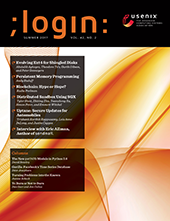USENIX supports diversity, equity, and inclusion and condemns hate and discrimination.
An Interview with Peter G. Neumann
;login: Enters a New Phase of Its Evolution
For over 20 years, ;login: has been a print magazine with a digital version; in the two decades previous, it was USENIX’s newsletter, UNIX News. Since its inception 45 years ago, it has served as a medium through which the USENIX community learns about useful tools, research, and events from one another. Beginning in 2021, ;login: will no longer be the formally published print magazine as we’ve known it most recently, but rather reimagined as a digital publication with increased opportunities for interactivity among authors and readers.
Since USENIX became an open access publisher of papers in 2008, ;login: has remained our only content behind a membership paywall. In keeping with our commitment to open access, all ;login: content will be open to everyone when we make this change. However, only USENIX members at the sustainer level or higher, as well as student members, will have exclusive access to the interactivity options. Rik Farrow, the current editor of the magazine, will continue to provide leadership for the overall content offered in ;login:, which will be released via our website on a regular basis throughout the year.
As we plan to launch this new format, we are forming an editorial committee of volunteers from throughout the USENIX community to curate content, meaning that this will be a formally peer-reviewed publication. This new model will increase opportunities for the community to contribute to ;login: and engage with its content. In addition to written articles, we are open to other ideas of what you might want to experience.

I first encountered Peter G. Neumann at the PC party for Security in Washington, DC, back around 2000. Peter was playing a grand piano and leading a group in singing songs from Gilbert and Sullivan, Tom Lehrer, and more. I later learned that Peter can play many more instruments.
Peter and I met for lunch in 2007 in Palo Alto, not far from where he works at what used to be Stanford Research Institute and is now SRI International. I was going to speak at Apple and Google over the following week about the failure of current measures that were supposed to be making our systems more secure. Peter encouraged me, then regaled me with stories about the Multics design.
Peter has been involved in security since 1965, starting with his work on the Multics file system and overall Multics development, continuing with a provably secure operating system (PSOS). His current project involves the CHERI (Capability Hardware Enhanced RISC Instructions) hardware-software system co-design [1]).

